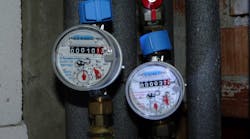Latest from Green
Sponsored
Water efficiency sometimes falls into the background in conversations about the climate crisis. Massive topics like renewables, greenhouse gas emissions, deforestation and electric vehicles often take the spotlight. However, to truly move forward with green building practices, all contracting teams must consider water efficiency.
Plumbers have an especially central role when it comes to water conservation and sanitation. They must ensure the correct amount of water flows to a home or building without it being wasteful. A Leadership in Energy and Environmental Design (LEED) certification is one model to aid this process as system designers work towards full sustainability.
And of course, the reverse is true as well. Without full water efficiency, buildings will not be able to receive LEED certification.
Plumbers Must Focus on Water Efficiency
According to the U.S. Geological Survey, about 1.7 trillion gallons of water are wasted every year. According to the EPA web site, the average household's leaks can account for nearly 10,000 gallons of water wasted every year; ten percent of homes have leaks that waste 90 gallons or more per day. To conserve water and use it more effectively new buildings must adhere to better water integrations.
Plumbers can act by breaking down water efficiency into two categories—indoor and outdoor sources. Indoors, water must flow to toilets, sinks, bathtubs, showers, dishwashers and washing machines. Some buildings will have water dispensers, too. These appliances require cutbacks on consumption and waste.
Outdoor water usage consists of hoses, irrigation systems, wells and pipes that transfer city water in and wastewater out. While retrofitting older buildings to be more efficient is possible, keeping these areas in mind with newer construction will save money in the long run and prevent massive changes in the future. The most efficient balance of these indoor and outdoor water supplies—and how to achieve it—is reflected the LEED point system.
LEED Water Efficiency Certifications
From 2015 through 2018, LEED-certified buildings helped save $149.5 million worth of water, $715.3 million on maintenance $52.2 million on waste, not to mention $1.2 billion in energy costs. To properly attain a full LEED certification, and the cost-saving benefits that come with it, plumbers must ensure the building meets three water efficiency requirements.
A platinum certification means a structure achieved at least 80 points total. The three water efficiency requirements add up to a total of 10 points, according to their individual pages on the U.S. Green Building Council (USGBC) website. Here’s the breakdown:
1. Water-Efficient Landscaping
The water-efficient landscaping goal makes up the first five points for overall efficiency. This tier involves reevaluating how a building uses potable water. Too often, outdoor water will go to waste—the building overuses it when it only needs a portion. Limiting or altogether eliminating the use of that potable water will earn the necessary points toward a LEED certification.
The irrigation on or near the site needs to be completely efficient, with no overuse of water. According to USGBC, a 50 percent reduction in potable water use results in one point, 75 percent earns three points and 100 percent gets all five.
Using a smart meter for this step is ideal. It can track and report, in real-time, the amount of water a building uses through landscaping. This includes how much goes into the site for construction and landscape maintenance. However, plumbers will also need to monitor if the site disrupts any natural bodies or occurrences of water since that can factor into the certification.
2. Innovative Wastewater Technologies
Wastewater is one of the biggest factors when it comes to water efficiency. It flows through buildings’ sewer lines throughout the day. This tier entails reducing by 50 percent potable water use for wastewater and sewage conveyance. Outdoor, nonpotable water can also factor into this reduction.
Again, smart water meters are essential. They’ll show plumbers and building residents or owners how much water the site consumes for wastewater. From there, they can install low-flow versions of appliances that produce wastewater. For instance, low-flow toilets will use less water and aid the reduction process. Plumbers should also place smart leak detectors at each location where wastewater flows to fix issues as they arise, saving water and money.
It’s critical to remember that wastewater doesn’t solely come from bathrooms. Showers, dishwashers, sinks and washing machines produce it as well. Using these smart technologies in all areas will ensure the best monitoring practices. They will help achieve the LEED certification.
3. Water Use Reduction
Overall water-use reduction is the last factor for efficiency in the LEED certification process. This tier differs from the other two because it requires a dual reduction—both from the structure itself and during the process. Plumbers need to reduce building and process water use by 40 percent to achieve the total four points from this tier.
Water efficiency within the building must be at peak levels. The water use reduction points require that plumbers consider every residential or commercial appliance and fixture that uses water, even the subtlest ones, like coffee makers. Low-flow gadgets will help plumbers attain these four points.
This step completes the three-factor process of achieving ideal water efficiency for a LEED certification. Without these three fields, the certificate would be unattainable.
Goals and Benefits
A focus on sustainability achieves what’s known as the triple bottom line—the idea that eco-friendliness saves money, helps the public and creates a cleaner environment. Obtaining a LEED certification is a primary way to achieve this triple bottom line, which is not possible without optimal water efficiency.
Smart gadgets and the reworkings of waterlines and fixtures ensure a building saves money and water. Utility bills will decrease while the structure itself contributes to solving various water crises around the world. More water conservation results in a healthier environment and more access to clean water for everyone.
The Recurring Tech Theme
Technology comes in as the solution throughout each of these three certifications. It helps the first stages of construction, where plumbers and contractors can monitor how much water they use, as well as the later stages where they need to focus on reducing potable water usage. Smart tools are required to achieve the best water efficiency and get LEED certifications.
Rose Morrison is a freelance writer who covers construction, home improvement, and contracting topics. She is also the managing editor of Renovated.com, a site dedicated to the latest trends in the home industry. She has a passion for innovative technologies that are making the home industry sustainable and efficient. Check out Renovated.com to see more of her work.

Rose Morrison
Rose Morrison is a freelance writer who covers construction, home improvement, and contracting topics. She is also the managing editor of Renovated.com, a site dedicated to the latest trends in the home industry. She has a passion for innovative technologies that are making the home industry sustainable and efficient. Check out Renovated.com to see more of her work.


